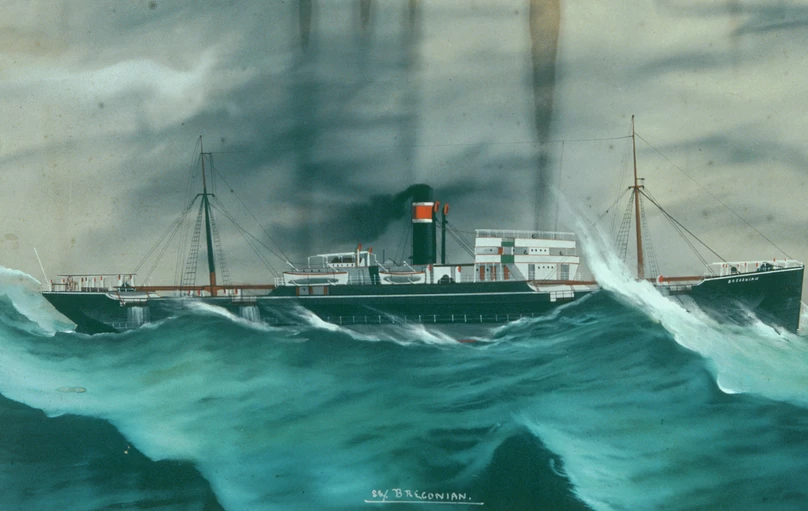When Welsh ships sailed the seas
Painting of the Breconian
The Breconian
The Breconian was built in 1906; she was registered in Aberystwyth and was sailed by Welshmen across the oceans of the world for thirty years. Her portrait, one of the industrial paintings of ships in Amgueddfa Cymru's collection, reveals a fascinating insight into days gone by.
Ship Paintings
The industrial collections house some 250 ship paintings. Few of these could be described as fine art, but they do provide an invaluable archive of Welsh maritime history. Most of these paintings are the work of Mediterranean 'pierhead painters' who, for a small sum, would produce simple colourful pictures of a vessel for the owner, captain or crew members.
Originally, they were painted in pairs, one painting of the vessel on a calm sea and the other in a storm. What these paintings lack in artistic quality is made up for by their technical accuracy. These paintings became objects of pride and sentiment, as much to the ship's owner as to the captain's wife.
A ship with a new design
The painting of the Breconian is an unsigned storm-scene portrait. The steamship was built for John Mathias & Sons of Aberystwyth. She was unusual in that she had been built with a new, narrower deck, the turret-deck, superimposed upon the vessel's hull, extending from stem to stern. This new design made the vessel more profitable to operate. The design was so successful that 429 turret-deckers were built between 1892 and1911.
The company that owned the Breconian began back in 1869 when John Mathias, an ambitious Aberystwyth greengrocer, decided to venture into shipowning, buying the schooner Miss Evans.
In 1883 he moved from sail to steam, forming the Glanrheidol Steamship Company Limited. By the time that the Breconian joined the Mathias fleet, the business had been grandly renamed the Cambrian Steam Navigation Company Limited, with the seven ships of the line being named, rather unusually, after public schools. This led to seamen at Cardiff giving the company the nickname of 'the College line'.
The Breconian, named after Christ College, Brecon, was the only vessel named after a Welsh school; the others being Etonian, Harrovian, Rugbeian and so on.
Coal out, grain home
Like most tramp steamers of the period, the Breconian would have sailed chiefly in the so-called 'coal out, grain home' trades, taking coal from south Wales across the world and returning with a cargo of cereals. She was manned mainly by Welshmen; in 1911, her master was Captain David Jones of Aberystwyth and 20 of her 28 strong crew came from Welsh coastal towns and villages.
In 1917, The Breconian was sold to the Tyneside Line Limited of Newcastle and in 1926 she was sold on to a Genoese shipowner, Giovanni Bozzo, who renamed her Lorenzo Bozzo after his son. Six years later she was broken up. Today, only the painting remains to remind us of just one aspect of the flourishing Welsh maritime enterprise and the capable Welsh seamen who sailed the world's oceans.


Comments - (1)
I was expecting to see some reference to the ships sailing from and built in Pembroke Dock. My father flew as a Navigator in Sunderlands from PD and Oban during WWII and I was told that sailing ships preceded the Sunderland Squadrons at the dockyard in PD - there was a small ship building yard at the bottom of Meyrick Street just past the old cinema - along I think it was called Water Street - as a child one could hear the riveters working - I also remember some reference to HMS Warrior which I believe was an early iron clad ship - when I joined the and was professed in the Franciscan Secular Order at St Cuthbert's Church in the docks when at Cardiff University studying engineering with Professor Emrys Williams - a fine teacher and a very kind and loving man who set a standard for myself later when I became a lecturer myself, after one visit to St Cuthbert's I met a very interesting old gentleman from Sweden who very kindly invited me to his home thereabouts to have a coffee and where he told me he had sailed the wooden sailing ships as boy and man and about going up the rigging in high winds as his ship traversed Cape Horn - wild and dangerous times indeed - perhaps it was not as tough nor as dangerous as going down the mines and much more exciting.
When some persons I have met in London stress the dreadful times their ancestors had in the Slave Trade, despite necessarily showing great sympathy for such an enormity of dehumanising suffering, empathetically I I make a point of pointing out that this abuse of humankind is not unique - everywhere Capitalists tread with their indifferent bloodying feet and make other people suffer, and to note that Welsh men died and were badly injured down the mines of South Wales: no fresh air, fruit or sunshine there but a penetrating dangerous barely lit darkness. Welsh coal drove the steamships of the world and what did poor little near forgotten Wales get out of it - not the wealth that landowners and mine-owners gained, enjoyed and squandered from miners ox-like efforts but a despoiled countryside glistening black with dangerous slag-heaps.
Thankfully, as the tv programme presented by Lord Bragg showed, the valleys are being slowly restored by a massive clearance of the remains of the coal fields to hopefully one day their former verdant glory - but sadly with not enough employment to maintain their population nor to alleviate the drug driven despair and despondency of the young.